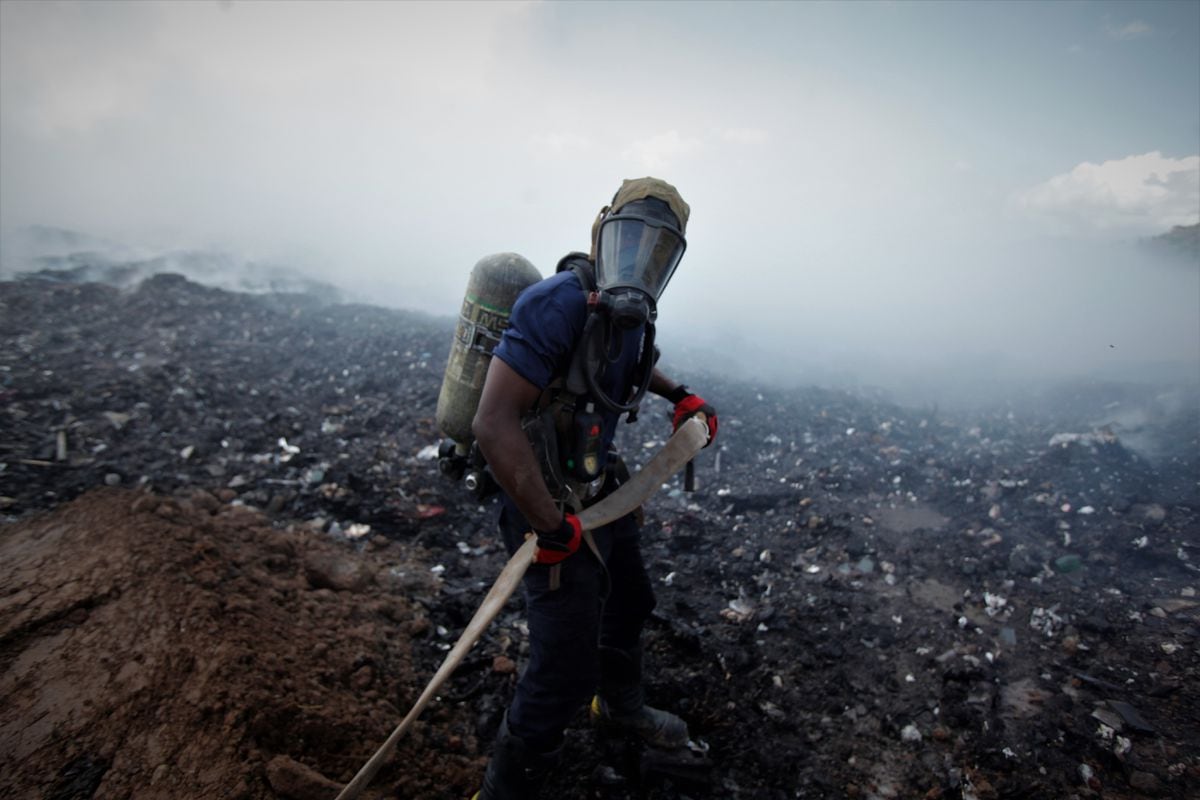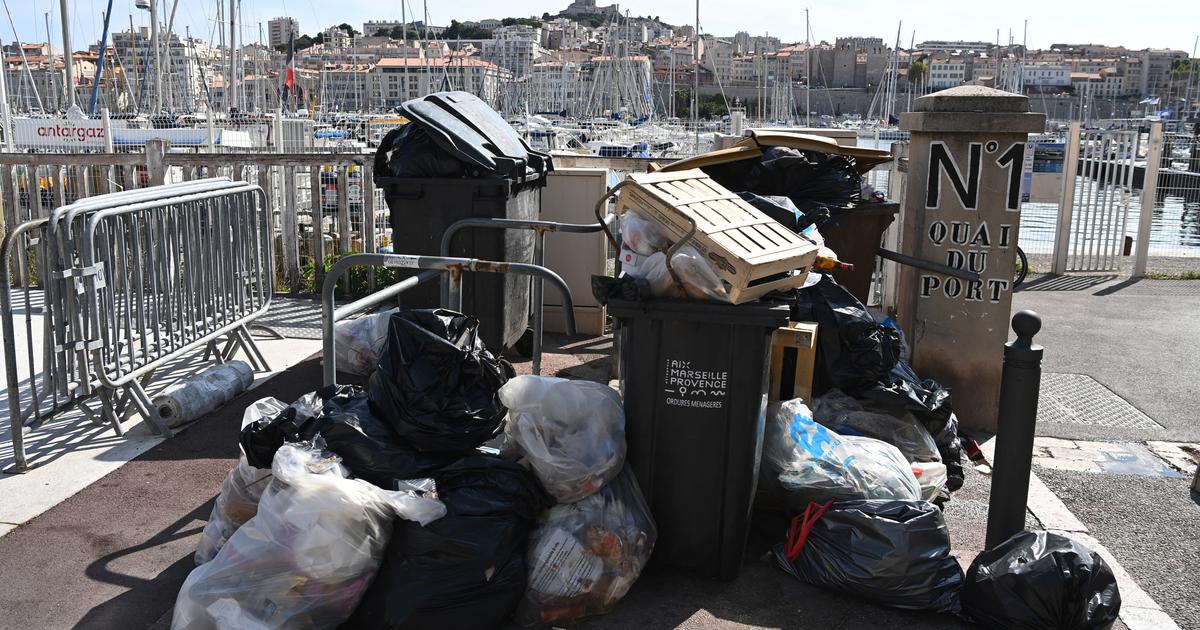Global society
all articles
Every morning, before dawn, Jasmudin Khan * walks through hell. He wades through plastic; he jumps over a stream of black, dirty water. He walks past trees, in whose bare branches plastic scraps hang like tinsel.
Pigs wallow in the dirt. It is a steep and arduous climb. Khan sweats, chasing away the flies from his arm with his hand. The 37-year-old wants to go up to the summit, and the closer he gets to him, the stronger the smell of decay.
The mountain that Khan climbs is not a mountain of rock but a 62-meter-high heap of rubbish and rubble. He can already be seen from many miles away. During the day crows and hawks circle above the summit. At night you see the fire - garbage fires that pollute the air.
Enrico Fabian
The 14-year-old son of Khan carries lunch in a bag for his father, who works like many others from the family here as a garbage collector
At the top, many are waiting like Khan, including children. They carry hoes over their shoulders like miners.
Their pants are dusty, their faces too. The bare feet of most are in flip flops, almost nobody wears gloves. Trucks rumble, dumping their cargo: packaging, building rubble and leftovers. Khan ties a cloth around his mouth, and then, together with the others, starts digging through the wet garbage.
Delhi's Bhalswa Landfill is one of India's largest landfill sites with its 20 hectares - and Khan's workplace. As a garbage collector, he earns money with things that are no longer worth anything to other people. The work is dangerous. But garbage collection promises income to thousands of the poorest. And somebody has to make sure that the garbage is processed, that Delhi's mountains of garbage do not get any higher.
Enrico Fabian
View of Bhalswa, a gigantic garbage mountain in India's capital Delhi
Every day, citizens in the capital Delhi produce an estimated 10,500 tons of waste. That's more than the city's three landfills can handle.
Ghazipur, the largest heap, has now grown to 65 meters - at its current growth rate, it could top the Taj Mahal at 73 meters next year, a senior inspector recently warned. The pictures of the garbage mountains then went around the world. They became the symbol of India's garbage problem. The country does not produce so much waste:
- An Indian household accumulates 500 grams of waste per day on average; Americans and Germans, however, between one and a half and two kilograms - per person.
- Much of what is in the west in the bin is being repaired or reused here. Street stalls sell food wrapped in old newspapers or sheets. Cars are driven until they fall apart.
- More than half of all plastic is reused, globally it is just nine percent.
But that changes.
India's economy grew last year by about seven percent. Millions of people have escaped poverty, many more will follow. There were supermarkets and shopping centers. Billboards in Delhi advertise for smartphones from China and cars from Germany.
Enrico Fabian
Jasmudin Khan stuffs collected garbage into a big bag
On the dump there are disposable razors, toy cars, body lotion and aluminum foil. Things that until recently no one missed - and now want to own millions. In the world's largest future market, you can see the consequences of capitalism in real time - the good and the bad. Khan rips open a plastic bag with bare hands and pours out the contents. He pulls a stained measuring cup from the leftovers and a shoe sole.
The truck drivers come every few minutes, they drive fast and ruthlessly. The wheels whirl up dust that burns in the eyes and crunches between their teeth. A bulldozer levels the garbage. When he passes, the ground shakes. Dozens of people - sacks over their shoulders, wraps wrapped around their heads - walk in between. An older woman has stuck a magnet to a broomstick and is looking in the dirt for nails and coins. A girl uses a knife to cut the trolley out of a suitcase. She leaves the fabric.
Here you quickly learn what is worth lifting up and what is not. Khan can distinguish 70 types of garbage. Hard plastic (around 30 cents a kilo) or copper (around three euros). He sells what he finds to middlemen who in turn sell recycling companies. Almost everything here on the mountain has even more value, even hair.
photo gallery
14 pictures
Recycling in India: garbage collectors on the huge landfills of DelhiLike garbage, the garbage collectors guard the clumps of long black hair they have found. Sales price: around 25 to 35 euros the kilo. India is one of the largest suppliers of human hair wigs. Much of the hair comes from Hindu temples where women sacrifice them. But some just from the garbage.
There are larger landfills worldwide than those in Delhi. They are located in the US and Europe: Apex Regional in Nevada or Malagrotta near Rome. The landfill Fresh Kills near New York measured 69 meters at the end, today it is a park. In contrast to the garbage mountains in India, these heaps are usually better managed and are far out of town. The authorities ensure that the effluents do not poison the groundwater and that the methane gas that is produced inside is drained and captured by pipes instead of igniting like in Bhalswa. When the dumps are full, they are sealed and sealed.
Not in Delhi. All three landfills are said to have been decommissioned for about ten years, because they have more than doubled the statutory amount. Nevertheless, every day hundreds of trucks continue to roll over with garbage. The authorities do not know where to go. India lacks what is seldom lacking in the US, for example.
Enrico Fabian
Since 1984 there is the Bhalswa landfill - at the foot of the garbage mountain settle the collectors
When the authorities landed the garbage dump 35 years ago, no one could imagine that the city would even reach here. Today, Delhi has enclosed the landfill. The Müllberg can be easily reached by metro. And so it is self-made recyclers like Khan who saved Delhi's landfills from total chaos - until now. Because they are removing the garbage.
"We are in trouble," says Swati Singh Sambyal of the Center for Science and Environment in Delhi. "The way we live and shop changes, but we do not know how to handle the new consumption." There was a lack of space for new landfills and to bring the garbage out of the city, cost fuel and make the already stagnant traffic worse.
Burning it and getting energy out of it would not work, says Sambyal. India's garbage is mainly made of organic waste and it is moist. Burning it costs more electricity than can be gained from it. The waste incineration plants are therefore often silent.
Enrico Fabian
Shoes sorted by garbage collectors
Sambyal and other environmentalists are suggesting another solution: First, Delhi's citizens should start separating their garbage at home. This is already mandatory today, but only a few stick to it. The organic waste could then be composted, the rest recycled. Instead of large landfills, there would have to be many small ones spread out across the city. That worked in smaller Indian cities.
And then: consume less, or smarter. India wants to ban plastic bags, cups and straws - the so-called disposable plastic. Premier Narendra Modi encourages citizens to avoid garbage. But good ideas and laws have never been lost in India; the problem is often the implementation.
For a long time there have been plans to officially work for Delhi's garbage collectors. Their workforce is cheap and they have a knowledge that few have. Happened so far is little. And it will stay that way, Khan believes. "Too many have already promised us that something will change," he says.
Enrico Fabian
Khan washes after a long day at the landfill
It dawns when Khan comes home. He is tired, his clothes sweaty and full of mud, he staggers. Strip the sneakers and let water run into a bucket to wash. The water makes him sick, Khan believes. The wastewater from the garbage poison the groundwater. Many who live on the slopes suffer from dizziness, rashes, respiratory and diarrheal diseases. The garbage cuts into her hands.
On good days they find gold, bad cadavers, sometimes even corpses. Many are drug addicts, because the dirt and stench are only bearable in the intoxication. "The garbage collectors are an important service to the city, but they risk their lives for it," says Chitra Mukherjee of the relief organization Chintan.
Khan puts on a fresh shirt and pressed trousers, combing his hair to one side. He came home earlier today than usual. He could not anymore. While the others were gathering, sometimes he just stood there staring into space. For two days he has felt this pain in the middle of his chest, he says. Then he calls a rickshaw, his wife accompanies him. Khan goes to the doctor. He is afraid.
* Name changed
This article is part of the project Global Society, for which our reporters report from four continents. The project is long-term and supported by the Bill & Melinda Gates Foundation.
What is the project Global Society?
Under the title Global Society, reporters from Asia, Africa, Latin America and Europe will be reporting on injustices in a globalized world, socio-political challenges and sustainable development. The reportages, analyzes, photo galleries, videos and podcasts appear in the Politics Department of SPIEGEL. The project is long-term and will be supported over three years by the Bill & Melinda Gates Foundation (BMGF).
Are the journalistic contents independent of the foundation?
Yes. The editorial content is created without the influence of the Gates Foundation.
Do other media have similar projects?
Yes. Major European media such as "The Guardian" and "El País" have created similar sections on their news pages with "Global Development" or "Planeta Futuro" with the support of the Gates Foundation.
Was there already similar projects at SPIEGEL ONLINE?
SPIEGEL ONLINE has already implemented two projects in recent years with the European Journalism Center (EJC) and the support of the Bill & Melinda Gates Foundation: The "Expedition The Day After tomorrow" on Global Sustainability Goals and the journalistic refugee project "The New Arrivals" Several award-winning multimedia reports on the topics of migration and escape have emerged.
Where can I find all the publications on the Global Society?
The pieces can be found at SPIEGEL ONLINE on the topic page Global Society.









